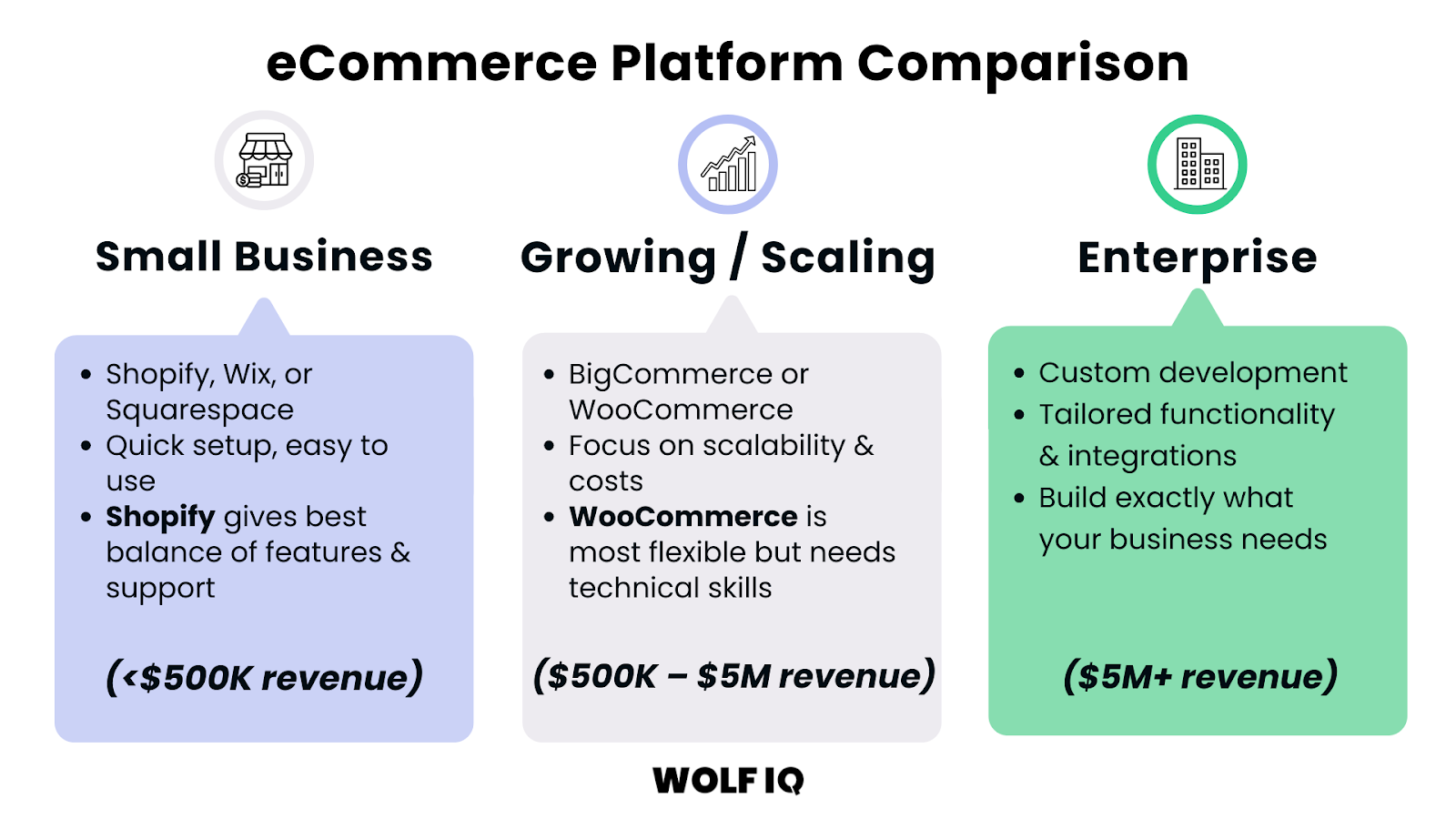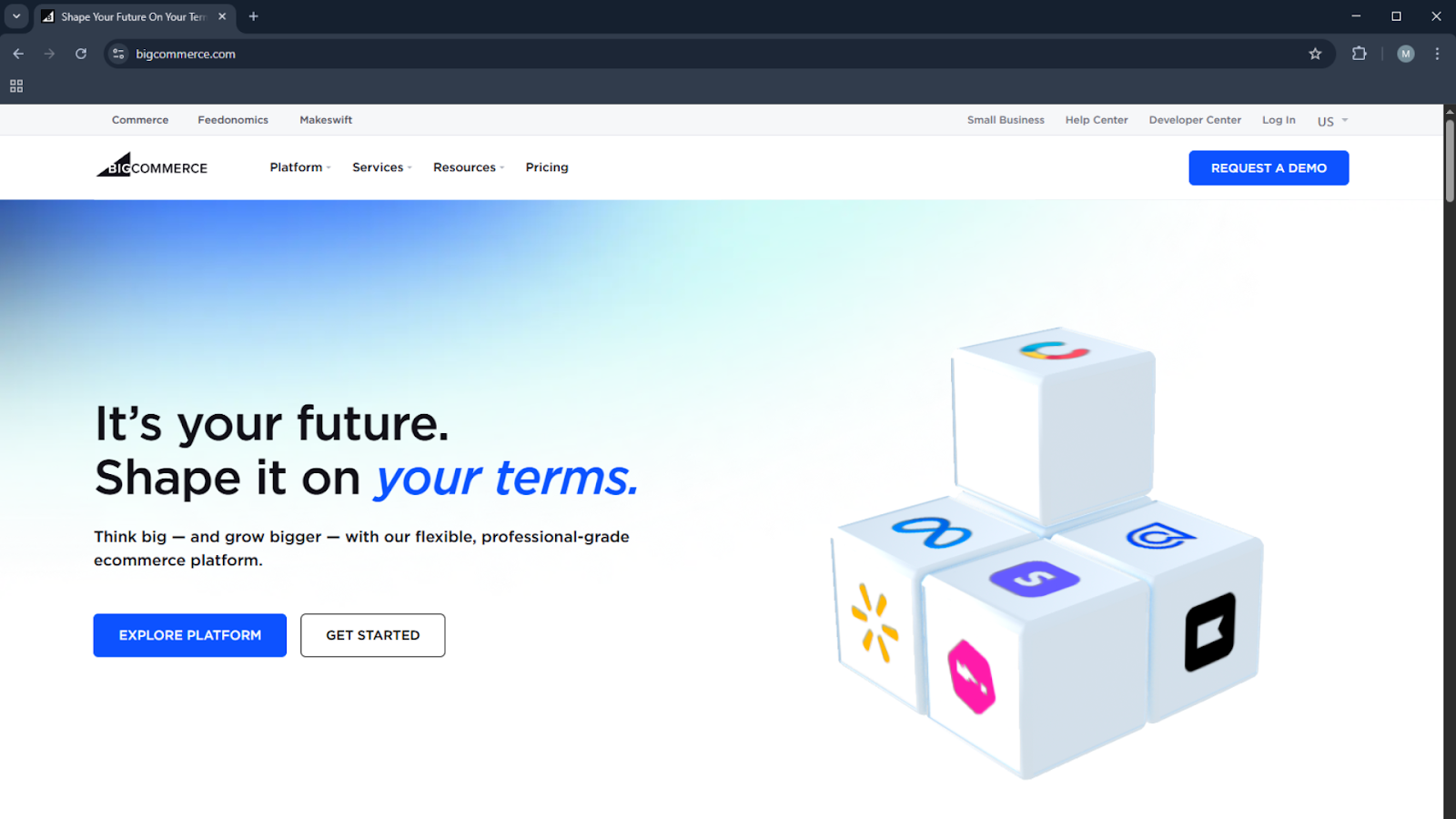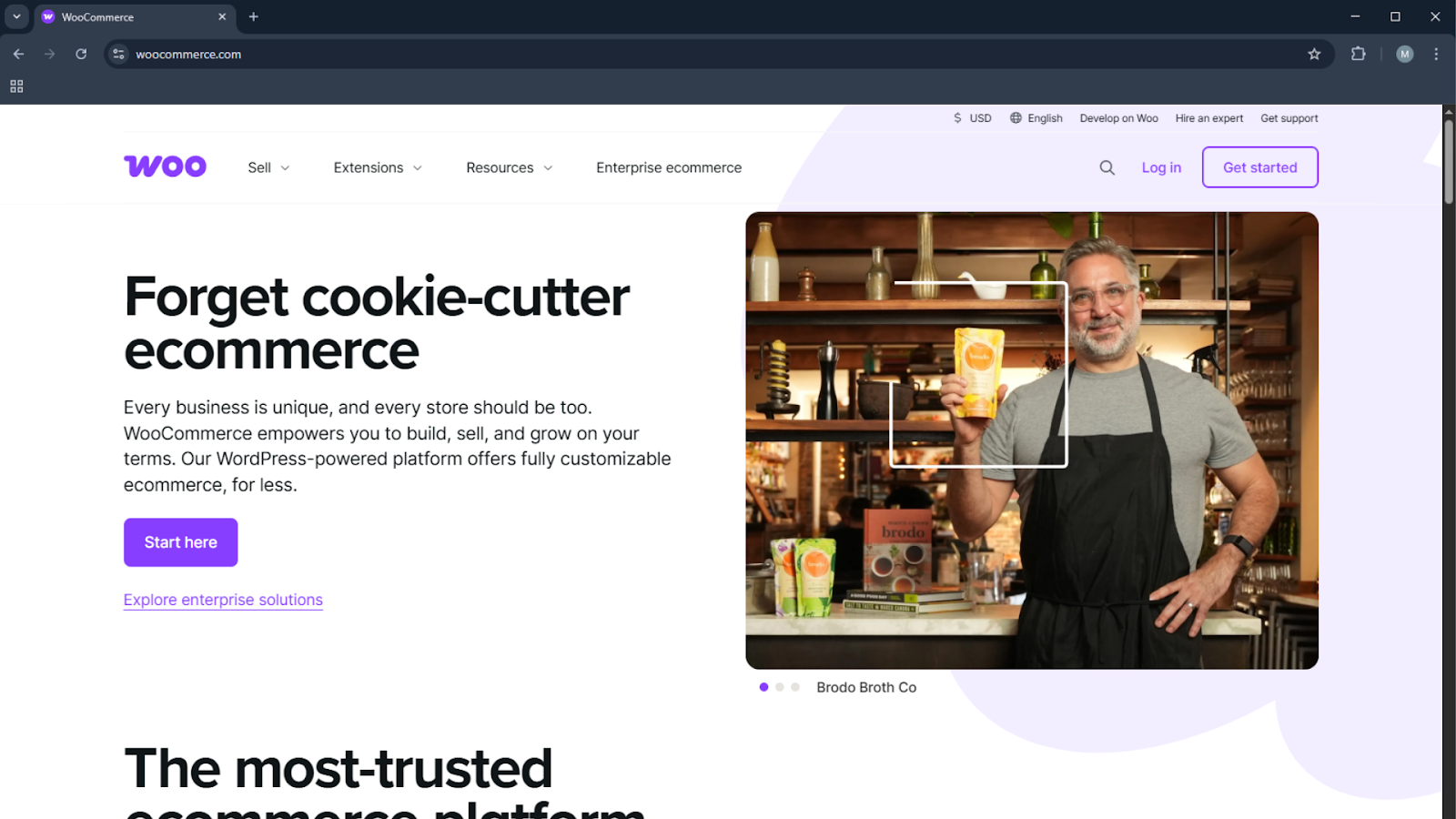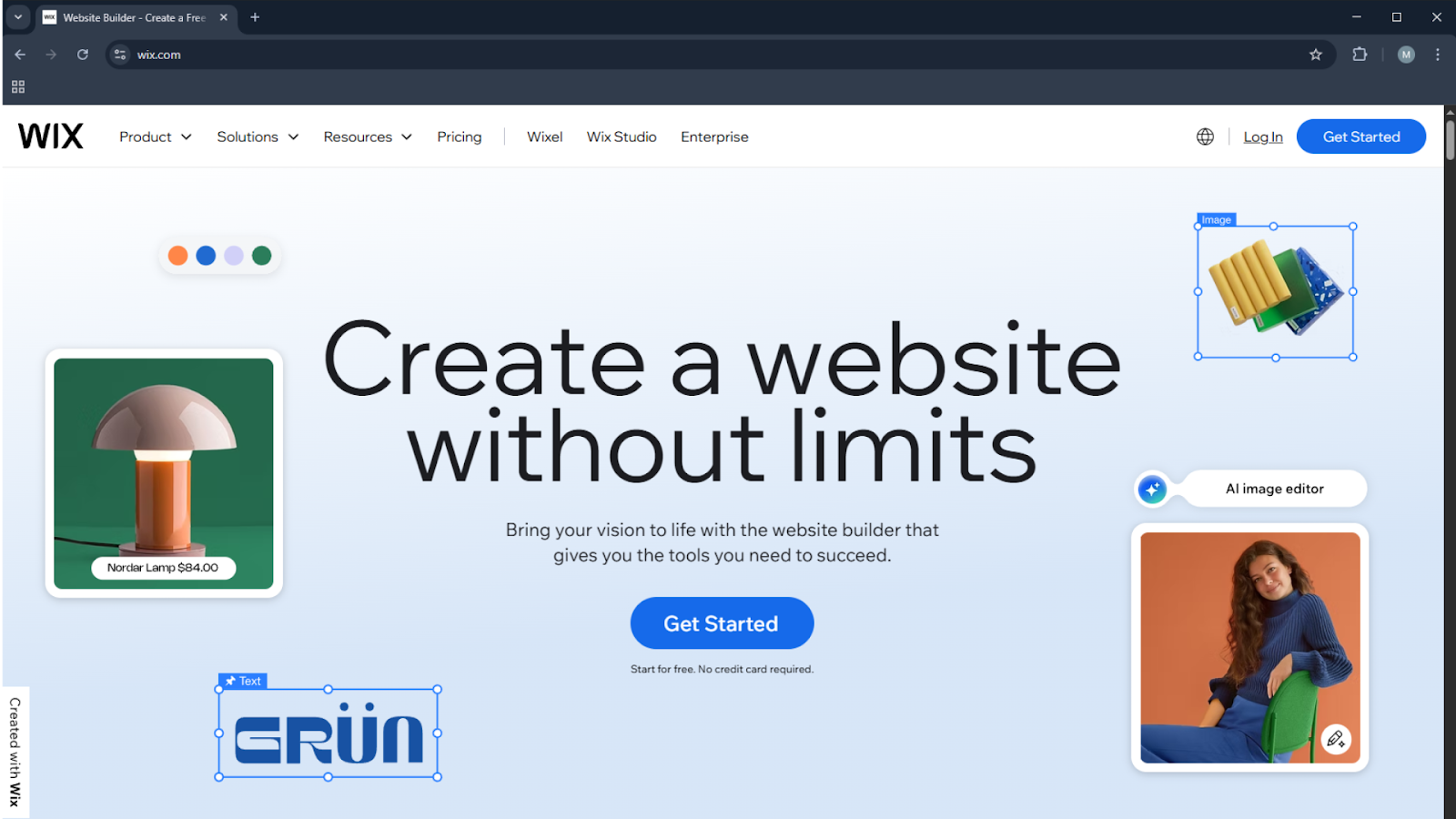Best eCommerce Platforms: A Comprehensive Comparison for Small Businesses
The Australian eCommerce landscape is experiencing unprecedented growth. Aussies spent $69 billion online last year according to Australia Post - that's $190 million per day!
For small business owners and marketing leaders looking to expand their online presence, choosing the right eCommerce platform has never been more critical to digital success.
This comprehensive guide examines the top eCommerce platforms available to Australian businesses in 2025, providing detailed comparisons of features, pricing, pros and cons, and real-world applications.
The platforms covered in this guide include Shopify, BigCommerce, WooCommerce, Wix and Squarespace. Each platform offers unique advantages depending on your business size, technical expertise, and growth aspirations.
Aussie eCommerce Considerations
The choice of eCommerce platform can make or break your online venture.
The wrong platform can limit your growth, increase operational costs, and frustrate both you and your customers.
Conversely, the right platform becomes a powerful engine for business growth, streamlining operations while providing the flexibility to scale as your business evolves.
Australian businesses face unique considerations when selecting an eCommerce platform.
These include GST configuration requirements, integration with local payment methods like Afterpay and Zip, AUD currency support, and compliance with Australian Consumer Law.
eCommerce Decision Framework
Selecting the right eCommerce platform requires careful consideration of multiple factors, including your business model, technical capabilities, growth plans, and budget constraints.
If you're overwhelmed with options, this framework can help you evaluate your options and make a fast decision.
When we run Wolf IQ platform‑selection workshops with clients we lead with three questions: (1) Where do we want to be in 24 months? (2) Which internal resources do we already have? (3) What key revenue lever does the platform unlock? Answering these prevents selecting a platform that ‘works today’ but blocks you later.

Startup/Small Business (<$500K annual revenue)
Consider Shopify, Wix, or Squarespace for quick deployment and ease of use. These platforms provide comprehensive functionality without overwhelming complexity or excessive costs.
Shopify offers the best balance of functionality, ease of use, and support. While not the cheapest option, its comprehensive feature set and extensive app ecosystem make it suitable for most business models and growth trajectories.
Growing Business ($500K-$5M annual revenue)
Evaluate BigCommerce or WooCommerce depending on your technical capabilities and customisation requirements. Focus on scalability and total cost of ownership.
WooCommerce provides unmatched flexibility and content management capabilities. However, it requires technical expertise or professional support to implement and maintain effectively.
Enterprise Business ($5M+ annual revenue)
Custom development becomes a viable option.
This allows you to build exactly what your business needs, and implement advanced integrations that traditional platforms can’t provide.
eCommerce Platforms Comparison Table
Not all eCommerce platforms are created equal. Each comes with different costs, hidden fees, and strengths that make it better suited for certain types of businesses.
Here’s a side-by-side comparison of the major platforms—what they cost, what surprises to expect, who they’re best for, and the “secret sauce” that makes each unique.
Based on our Wolf IQ client portfolio, we repeatedly see three hidden cost traps in eCommerce platforms: unexpected app/plug‑in fees, migration/SEO losses when moving platforms, and under‑estimating hosting or payment‑gateway costs. We’ll draw attention to these as we go.
Understanding Platform Types
Before diving into specific platform comparisons, it's essential to understand the different types of eCommerce solutions available.
Each type offers distinct advantages and limitations that may align differently with your business needs and technical capabilities.

Software as a Service (SaaS) Platforms
SaaS platforms like Shopify, BigCommerce, and Wix operate on a subscription model where the platform provider handles hosting, security, updates, and technical maintenance.
These platforms offer the quickest path to market with minimal technical requirements.
Open Source Solutions
Platforms like WooCommerce (WordPress) and Magento Community Edition provide maximum flexibility and customisation options.
However, they require more technical expertise and self-managed hosting.
Hybrid Solutions
Some platforms offer hybrid approaches like Magento Commerce (Adobe Commerce Cloud), combining the ease of SaaS with increased customisation options.
These solutions attempt to balance convenience with flexibility.
Advantages: Better customisation than pure SaaS while maintaining some managed services benefits.
Limitations: Often more expensive than pure SaaS solutions and may still have customisation limitations.
eCommerce Platform Comparisons
1. Shopify
Shopify has established itself as the dominant force in the global eCommerce platform market, and for good reason.
As of 2025, it powers over 4.8 million active websites globally,, offering a compelling combination of ease of use, extensive functionality, and scalability that appeals to businesses of all sizes.

Why Shopify Excels for Australian Businesses
Shopify's strength lies in its ability to get businesses online quickly without requiring technical expertise.
The platform's user-friendly interface allows entrepreneurs to set up a professional-looking online store within hours rather than weeks.
This rapid deployment capability is particularly valuable for Australian small businesses looking to capitalise on market opportunities or respond quickly to changing consumer demands.
The platform's extensive app ecosystem is another significant advantage. With thousands of apps available in the Shopify App Store, businesses can add functionality for email marketing, inventory management, customer reviews, social media integration, and much more.
This modular approach means you can start simple and add features as your business grows, avoiding the complexity and cost of over-engineering your initial setup.
For Australian businesses, Shopify offers excellent local support including AUD currency handling, GST configuration, and integration with popular local payment methods.
The platform's partnership with payment providers like Airwallex enables businesses to accept payments in 160+ local payment methods across 180+ countries, making international expansion more accessible.
Comprehensive Cost Analysis
Understanding Shopify's true cost requires looking beyond the monthly subscription fee to include transaction costs, apps, themes, and additional services.
- Here’s a breakdown of Shopify's typical costs in Australia based on recent data from AIAD:
- Basic Shopify: $42 AUD per month
- Shopify: $105 AUD per month
- Advanced Shopify: $431 AUD per month
- Shopify Plus: Starting at $3,000 AUD per month
Transaction Fees: When using Shopify Payments, credit card rates start from 1.75% + 30¢ per transaction for the Advanced plan, scaling up to 2.9% + 30¢ for the Basic plan. If you choose to use external payment gateways, additional transaction fees of 0.5% to 2% apply on top of your payment processor's fees.
Additional Costs to Consider: Premium themes range from $200 to $400 AUD, though free themes are available. Popular apps can cost anywhere from $10 to $100+ per month each. For a typical small business, expect to spend an additional $100-300 per month on apps and services once your store is established.
Real-World Example: Sarah's Sustainable Skincare, a Melbourne-based startup, started with Shopify Basic at $42/month. After adding essential apps for email marketing ($29/month), product reviews ($15/month), and inventory management ($39/month), plus a premium theme ($280 one-time), her total first-year platform costs were approximately $1,800 AUD. As her business grew to $50,000 monthly revenue, she upgraded to the standard Shopify plan, bringing her annual platform costs to around $2,400 AUD while saving on transaction fees.
Strengths and Limitations of Shopify
Best Use Cases
Shopify excels for entrepreneurs and small businesses that prioritise speed to market and ease of use over extensive customisation.
It's particularly well-suited for product-focused businesses, dropshipping operations, and companies planning to sell across multiple channels, including social media and marketplaces.
The platform is ideal for businesses that want to focus on marketing and sales rather than technical management.
If you're comfortable with some limitations in exchange for reliability and support, Shopify represents an excellent choice for most Australian small businesses.
2. BigCommerce
BigCommerce positions itself as a more scalable and feature-rich alternative to Shopify, particularly appealing to businesses with growth ambitions or those requiring more advanced built-in functionality without relying heavily on third-party apps.

BigCommerce's Competitive Advantages
The platform's most significant advantage is its comprehensive built-in feature set. Unlike Shopify, which relies heavily on apps for advanced functionality, BigCommerce includes sophisticated SEO tools, advanced product options, multi-channel selling capabilities, and detailed analytics as standard features.
This approach can result in lower total cost of ownership, particularly for businesses that would otherwise need multiple paid apps.
BigCommerce's commitment to no transaction fees sets it apart from competitors. Regardless of which payment gateway you choose, BigCommerce doesn't add additional transaction fees, potentially saving businesses thousands of dollars annually compared to platforms that charge these fees.
The platform's API-first architecture makes it particularly attractive for businesses with custom integration requirements or those planning significant customisation.
This technical flexibility, combined with built-in enterprise features, makes BigCommerce a strong choice for businesses planning rapid growth.
Detailed Pricing Structure
Monthly Plans:
- Standard: $39 AUD per month (up to $65K annual sales)
- Plus: $105 AUD per month (up to $400K annual sales)
- Pro: $431 AUD per month (unlimited sales)
- Enterprise: Custom pricing starting around $4,000 AUD per month
Sales Thresholds: Unlike other platforms, BigCommerce enforces sales thresholds. If your annual sales exceed your plan's limit, you must upgrade to the next tier. This can result in unexpected cost increases for rapidly growing businesses.
Additional Costs: Premium themes range from $200-400 AUD, similar to Shopify. However, BigCommerce's reduced reliance on paid apps can result in lower ongoing costs. Most businesses can operate effectively with $50-150 per month in additional app costs, compared to $100-300 for equivalent Shopify functionality.
Case Study: James's Electronics Emporium in Brisbane started with BigCommerce Standard at $39/month. The built-in SEO tools, product comparison features, and abandoned cart recovery meant he only needed two additional apps: advanced shipping ($25/month) and customer reviews ($19/month). His total monthly platform cost remained under $85 AUD even as his business grew to $60,000 monthly revenue, demonstrating BigCommerce's cost-effectiveness for growing businesses.
Strengths and Weaknesses of BigCommerce
Ideal Business Profiles
BigCommerce is particularly well-suited for businesses with moderate technical capabilities that want to minimise ongoing app costs while maintaining growth flexibility.
It's excellent for B2B businesses, companies with complex product catalogues, and those requiring advanced SEO capabilities.
The platform works best for businesses that can invest time in initial setup and configuration in exchange for lower ongoing costs and better built-in functionality.
If you're planning significant growth or have complex product requirements, BigCommerce offers excellent scalability without the app dependency issues common with other platforms.
3. WooCommerce
WooCommerce represents the most popular open-source eCommerce solution, powering around 4.65 million active stores globally as of mid‑2025. It holds about 20%+ of the global eCommerce platform market share.
As a WordPress plugin, it offers unparalleled customisation flexibility while leveraging the world's most popular content management system.

The WordPress Advantage
WooCommerce's integration with WordPress provides unique advantages for content-driven businesses. If your marketing strategy relies heavily on content marketing, blogging, or SEO, the combination of WordPress's superior content management capabilities with WooCommerce's eCommerce functionality creates a powerful platform.
The open-source nature means no monthly platform fees, with costs limited to hosting, themes, and plugins. This can result in significantly lower total cost of ownership, particularly for businesses with technical capabilities or access to development resources.
The customisation possibilities are virtually unlimited. With access to the underlying code and thousands of plugins, businesses can modify every aspect of their store's functionality and appearance. This flexibility makes WooCommerce ideal for businesses with unique requirements that can't be met by standard SaaS platforms.
Cost Structure and Considerations
Core Costs:
- WooCommerce plugin: Free
- WordPress hosting: $15-100+ AUD per month depending on requirements
- SSL certificate: $50-200 AUD annually (often included with hosting)
- Premium theme: $50-200 AUD one-time cost
- Essential plugins: $100-500 AUD annually
Hidden Costs: The "free" nature of WooCommerce can be misleading. Professional hosting, security measures, regular updates, and backup solutions are essential but not included. Many businesses underestimate the ongoing maintenance requirements and associated costs.
Development costs can vary dramatically. Simple customisations might cost $500-2,000 AUD, while complex custom functionality can require $5,000-20,000+ AUD investment. Ongoing maintenance and updates typically cost $100-500 AUD monthly for professional management.
Success Story: Melbourne-based artisan coffee roaster "Beans & Beyond" chose WooCommerce to integrate their extensive blog content with eCommerce functionality. Their annual platform costs total approximately $1,200 AUD (hosting, plugins, and maintenance), significantly less than equivalent SaaS solutions. However, they invested $8,000 AUD in initial custom development and spend $300 monthly on professional maintenance, bringing their total first-year cost to $12,800 AUD.
Advantages and Challenges
Best Fit Scenarios
WooCommerce excels for businesses that prioritise content marketing, require extensive customisation, or have access to technical resources. It's particularly suitable for businesses with unique product types, complex pricing structures, or integration requirements that can't be met by standard platforms.
The platform is ideal for businesses comfortable with technical responsibility in exchange for maximum flexibility and lower ongoing costs. If you have a WordPress website or plan to invest heavily in content marketing, WooCommerce provides seamless integration between content and commerce.
4. Wix
Wix has carved out a significant niche in the small business market by prioritising design flexibility and ease of use. With its drag-and-drop interface and extensive template library, Wix appeals to businesses that want professional-looking websites without technical complexity.

Design and Usability Focus
Wix's greatest strength lies in its intuitive visual editor. The drag-and-drop interface allows users to create unique layouts and designs without any coding knowledge.
With over 900+ templates available, businesses can find designs that closely match their brand vision and industry requirements.
The platform's design-first approach extends to its eCommerce functionality.
Product galleries, checkout processes, and promotional elements can all be customised visually, giving businesses significant control over their store's appearance and user experience.
For Australian small businesses prioritising brand presentation and visual appeal, Wix offers capabilities that rival custom-designed websites at a fraction of the cost and complexity.
Pricing and Value Proposition
eCommerce Plans:
- Business Basic: $23 AUD per month
- Business Unlimited: $33 AUD per month
- Business VIP: $46 AUD per month
Transaction Fees: Wix doesn't charge transaction fees, but payment processing fees apply through integrated payment providers. Australian businesses typically pay 2.9% + 30¢ per transaction through standard payment processors.
Additional Considerations: Most businesses find the Business Unlimited plan sufficient, providing unlimited bandwidth, 35GB storage, and comprehensive eCommerce features. Premium apps and additional storage may add $20-50 monthly to costs.
Real Example: Sydney-based boutique "Urban Threads" chose Wix Business Unlimited for $33/month. The owner, Lisa, valued the design flexibility and spent two weeks creating a unique store layout that perfectly matched her brand aesthetic. Her total monthly costs, including apps, remain under $60 AUD, while achieving a professional appearance that would have cost thousands with custom development.
Strengths and Limitations
Optimal Use Cases
Wix excels for small businesses where visual appeal and brand presentation are paramount.
It's particularly suitable for creative industries, fashion boutiques, restaurants, and service-based businesses, adding product sales to their offerings.
The platform works best for businesses with straightforward product catalogues and standard eCommerce requirements.
If your priority is creating a unique, visually appealing online presence without technical complexity, Wix offers excellent value and capability.
5. Squarespace
Squarespace has built a reputation for delivering exceptionally beautiful, modern website designs with integrated eCommerce functionality.
The platform targets businesses that prioritise aesthetic excellence and are willing to pay premium prices for superior design quality.

Design Excellence and Brand Focus
Squarespace templates are renowned for their modern, sophisticated aesthetics. Each template is professionally designed with careful attention to typography, spacing, and visual hierarchy.
This design quality makes Squarespace particularly attractive to creative professionals, luxury brands, and businesses where visual presentation directly impacts sales.
The platform's design philosophy extends beyond templates to include integrated features like professional photography tools, advanced image editing capabilities, and sophisticated layout options.
These features enable businesses to create compelling visual narratives that enhance their brand story and product presentation.
Investment and Returns
Pricing Structure:
- Business: $25 AUD per month (3% transaction fees)
- Basic Commerce: $35 AUD per month (no transaction fees)
- Advanced Commerce: $54 AUD per month (advanced features)
Value Considerations: While Squarespace's pricing is higher than some competitors, the included design quality and integrated features can provide significant value. Businesses often save on design costs, premium themes, and various apps that would be necessary on other platforms.
The platform includes advanced features like abandoned cart recovery, advanced analytics, and professional email campaigns as standard, reducing the need for additional subscriptions.
Strengths and Considerations
Best Applications
Squarespace is ideal for businesses where brand presentation and design quality are critical success factors.
It's particularly suitable for creative agencies, photographers, luxury goods retailers, and professional services firms that need to convey sophistication and quality through their online presence.
Taking Action
Success in eCommerce isn’t just about picking the right platform—it’s about launching confidently, improving continuously, and delivering an experience your customers trust and enjoy.
The best eCommerce platform is the one you actually launch and optimise over time. Too many businesses get stuck in analysis paralysis. But in reality, momentum wins. Start with what fits your business today, and scale as you grow.
At Wolf IQ, we build powerful, high-converting websites on WooCommerce and WordPress - tailored to your business needs, designed to scale, and backed by local experts who care about your success.
Whether you're managing thousands of SKUs, improving conversion rates, or building from scratch, we turn your website into your most valuable digital asset.
Wolf IQ has built 100s of eCommerce websites. We'd love to help.


.png)
.png)




.png)
.png)


.png)

